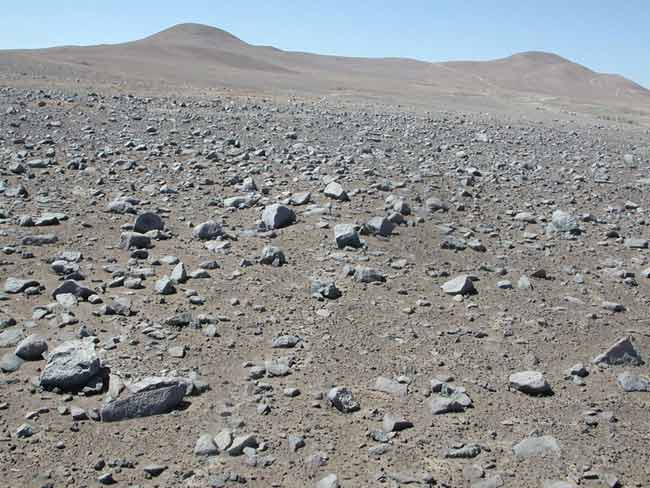
A chemical test used by the Mars Viking landers more than 30 years ago was not sensitive enough to detect signs of alien life even if they existed, a new study suggests.
Researchers analyzed soil from several harsh, Mars-like environments on Earth using the same gas spectrometry test employed by the Viking landers. But even in soil taken from areas teaming with microbial life, the tests failed to register any signs of organic material. Thus, "the Martian surface could have several orders of magnitude more organics than the stated Viking detection limit," the researchers write.
The finding, detailed in the current issue of the journal for the Proceedings of the National Academy of Sciences, could have implications for future missions aiming to dig up signs of extinct or existing life on the Red Planet.
The new study could also explain the detection of low levels of carbon dioxide in some Martian soil by the Viking landers, a puzzling finding that some scientists have used to argue for life on Mars.
In 1976, NASA's Viking 1 and 2 landers touched down on the Martian surface and proceeded to perform three separate experiments to detect signs of life. One of those experiments, called the thermal volatilization-gas-chromatography-MS, or TV-GC-MS for short, was designed to look for microorganisms living in Martian topsoil.
The test involved scooping up Martian soil, heating it up to 500 degrees Celsius (932 degrees Fahrenheit), and then analyzing the vaporized dirt for signs of organic molecules. But despite having sensitivities to organic molecules of a few parts per billion, no organic compounds were ever detected by either lander.
"The failure to detect organics by these techniques was used as the most compelling evidence against the existence of microbial activity on Mars," said study team member Rafael Navarro-Gonzalez of the National Autonomous University of Mexico in Mexico City.
Get the Space.com Newsletter
Breaking space news, the latest updates on rocket launches, skywatching events and more!
Prompted by NASA's upcoming Phoenix and Mars Scientific Laboratory-future missions with goals of finding signs of past or present Martian life-the researchers replicated the Viking landing experiments on soil taken from Mars-like environments here on Earth, including Antarctic dry valleys and arid deserts [image] in Chile and Peru. As a control, they also examined soil from the Rio Tinto [image], a river in Spain abundant in life and known to have high levels of organic molecules.
In all the samples, the researchers found low levels of organic compounds such as graphite that were not detected by the TV-GC-MS instrument. One possibility for the false-negative, the researchers said, is that iron in the soil oxidized organic molecules into carbon dioxide, reducing the amount of detectable material available for detection.
The finding could explain the low levels of carbon dioxide detected by Vikings' Labeled Release (LR) experiment. The results were initially attributed to the presence of microbial life in Martian soil, but when later experiments failed to match up with results from other tests, most scientists concluded the LR results were caused by unknown chemical processes.
"Our study clearly demonstrates that future Mars missions should include other methodologies in addition to this one to detect extinct or extant life on Mars," Navarro-Gonzalez told SPACE.com.
He added that NASA's Mars Science Laboratory (MSL), scheduled to launch in 2009, will not have the same limitations as the Viking landers because it will analyze the Martian soil in a slightly different way. "The problem is how to get the organics from soil to the spectrometer," Navarro-Gonzalez said. "Viking used the heating process. The MSL will extract organic compounds using solvents first and then volatize them chemically" before analysis.
"With MSL, we expect to be sensitive to a substantially broader range of organic molecules than Viking..." said Paul Mahaffy of NASA Goddard Space Flight Center in Maryland, the principal investigator for the mission's sample and analysis instrument.
For one thing, the MSL's Sample Analysis at Mars (SAM) experiment will be able to heat samples much higher than 500 degrees Celsius. "That was the temperature limit for the Viking GC-MS experiment and this may be an issue for organic molecule extraction from some samples," Mahaffy said.
The MSL will also cover a lot more ground than the Viking landers and scientists can now pinpoint promising sites for exploration using satellites, a luxury not available during the Viking era, he added.
- Digging and Sniffing for Life on Mars
- Rover Report Card: Prospect of Mars Life More Likely
- Mars Science Laboratory: Big Wheels on A Red Planet
- Scientists Say Mars Viking Mission Found Life
- Viking Data Still Cause Stir About Mars Life
Join our Space Forums to keep talking space on the latest missions, night sky and more! And if you have a news tip, correction or comment, let us know at: community@space.com.
Ker Than is a science writer and children's book author who joined Space.com as a Staff Writer from 2005 to 2007. Ker covered astronomy and human spaceflight while at Space.com, including space shuttle launches, and has authored three science books for kids about earthquakes, stars and black holes. Ker's work has also appeared in National Geographic, Nature News, New Scientist and Sky & Telescope, among others. He earned a bachelor's degree in biology from UC Irvine and a master's degree in science journalism from New York University. Ker is currently the Director of Science Communications at Stanford University.
